are nice and clean brand wipes fragrance free ?
The research
- Why you should trust us
- Who this is for
- How we picked
- Our picks: Disinfecting wipes
- Our picks: Disinfecting sprays
- A homemade disinfectant spray
- How to use disinfectant sprays and wipes
- Can rubbing alcohol, hydrogen peroxide, or other household disinfectants kill coronavirus?
- Notable alternatives
- The competition
Why you should trust us
For this guide, we spoke extensively with Mark Warner, education manager at the Cleaning Management Institute, a leader in training and certification for professional cleaning services. Warner is an expert on disinfectants and their proper use, and much of the information here comes from our interview. Guide author Tim Heffernan has spent considerable time determining the facts (and dismissing the hype) during his research into air purifiers, water filters, and water quality test kits—all experience that proved valuable as we assessed the latest news from the CDC and other agencies researching and reporting their findings on COVID-19.
Who this is for
Not all household cleaners are disinfectants. Disinfectants have to be able to kill virtually every type of bacteria and virus, and they have to kill virtually 100 percent of the pathogens present on the surfaces you use them on. In this guide, we're interested in killing things—like coronavirus—so household cleaners that are also disinfectants are the focus.
That said, sanitizing surfaces is not a bad idea, and as of April 2021, the CDC maintains its longstanding advice that people can "slow the spread" through daily disinfection of frequently touched surfaces and objects. In the CDC's words: "This includes tables, doorknobs, light switches, countertops, handles, desks, phones, keyboards, toilets, faucets, and sinks." The coronavirus is known to survive on plastic and steel for as long as three days (though the number of live viruses decays rapidly over that time), hence the daily regimen. The products below are safe to use on many of these surfaces, though you should always follow manufacturer instructions, as bleach-based disinfectants, especially, can damage some surfaces as well as fabrics and other soft materials.
Many people are worried about the potential for packages and mail to bring the virus into their homes. The virus may survive on cardboard boxes for up to 24 hours, but the CDC's position is that "because of poor survivability of these coronaviruses on surfaces, there is likely very low risk of spread from products or packaging that are shipped over a period of days or weeks at ambient temperatures."
How we picked
The definitive list of disinfectants that are approved to kill the COVID-19 coronavirus on hard surfaces is the EPA's List N. The EPA is regularly updating it and adding new products during the ongoing outbreak. We monitor the list to identify disinfectants that, in normal times, are sold widely to the public and all of our recommendations below are based on that criterion. The EPA has an excellent FAQ page that will help you understand the list and determine whether a given disinfectant that you already have on hand is approved.
To be called a disinfectant, a spray, soap, or wipe has to be able to kill virtually every type of bacteria and virus, and it has to kill virtually 100 percent of the pathogens present on the surface you use it on. We focused on true disinfectants that are specifically approved to kill the coronavirus that causes COVID-19.
Disinfectants are different from sanitizers, which "are not designed to kill all disease-causing microorganisms," Warner explained. "They're designed to kill most, down to a level that's considered safe," and "come into play on surfaces that can't be disinfected—porous surfaces, like your skin, fabric, and carpet." Other terms you may have seen on household cleaners and soaps include antimicrobial and antibacterial. "That doesn't mean that they're sanitizing or disinfecting," Warner said. "We see those claims on household cleaners and hand soaps. It's a bit of marketing, really." The FDA studied antimicrobial soaps and their active ingredients extensively and found that "manufacturers haven't shown that these ingredients are any more effective than plain soap and water in preventing illnesses and the spread of certain infections."
A List N entry means the EPA vetted the disinfectant and approved it to kill the coronavirus on the surfaces that disinfectant is designed for. Few have been directly tested on the COVID-19 coronavirus itself: "There aren't a lot of samples to do testing with," explained Warner. But the EPA's vetting is based on past testing on other viruses, including known human coronaviruses like the one that causes SARS (responsible for a global outbreak in 2003) and/or animal coronaviruses and/or viruses that have similar characteristics or are known to be tougher to kill. If a disinfectant is on List N, Warner said, "it is truly, truly effective on COVID-19."
List N disinfectants are generally designed to be used on hard, nonporous surfaces like metal (faucets, doorknobs), countertops (quartz, sealed granite), or glass and ceramic (sinks, tiles, tubs). They may not be effective on soft or absorbent materials like fabrics or rugs—and, in the case of bleach-based disinfectants, would likely cause irreparable damage.
The vast majority of List N disinfectants sold to the public fall into one of two categories: those based on bleach (sodium hypochlorite) or those based on quaternary ammonium (a class of compounds known generally as "quats"). List N also includes disinfectants based on other compounds, but those are largely restricted to commercial products aimed at the medical, pharmaceutical, industrial, and janitorial trades. "The most modern are those that are based on hydrogen peroxide" but are "much stronger than what you'd buy in a brown bottle at a pharmacy" and also contain substances that keep the peroxide stable and effective for longer, Warner said. Others incorporate concentrated isopropyl alcohol (rubbing alcohol) or ethanol (the kind of alcohol that some people drink). They're generally not available at retail.
Finally, List N distinguishes between product types. The category "Wipe" refers to, well, wipes—presoaked cloths, akin to baby wipes, that are designed to be used right out of the container. Then there are "RTU" (ready-to-use) spray bottles, aerosol cans, or liquids. And the "Dilutable" category refers to highly concentrated products aimed at (and largely available only to) commercial buyers because they must be mixed with water or other liquids and can be dangerous for untrained people to work with.
All of our recommendations are wipes or RTUs, and most are familiar products you used to find—and hopefully soon will again—on your local grocery store's shelves.
Our picks: Disinfecting wipes

Our pick
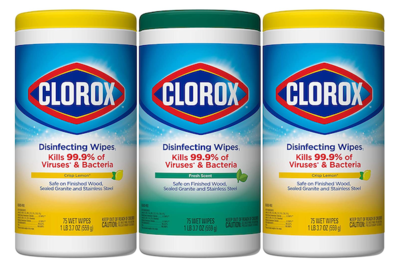
Clorox Disinfecting Wipes
Kill it with wipes
Effective, EPA-approved, and (usually) easy to find, these presoaked wipes need only four minutes of contact time to neutralize the coronavirus.
Buying Options
*At the time of publishing, the price was $5 .
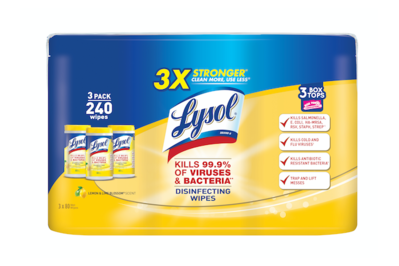
Clorox Disinfecting Wipes are rated to kill the COVID-19 virus in four minutes, as they use quaternary ammonium compounds ("quats") to kill viruses, bacteria, and other pathogens. Quats are gentler on surfaces than bleach-based disinfectants, and they're safer and more pleasant to use. All the various scents come under List N approval.
Lysol Disinfecting Wipes are on the EPA's List N, as well, meaning they are also rated to kill the coronavirus. They too use quaternary ammonium compounds to disinfect, but they take longer than the Clorox wipes: 10 minutes versus four.
As with all disinfectants, the so-called dwell time is important. For Clorox Disinfecting Wipes, the dwell time is four minutes. For Lysol Disinfecting Wipes, it's 10 minutes. That means you need to wipe down surfaces and let the disinfectant stand for at least four minutes or at least 10 minutes, respectively. To be thorough, it also means cleaning the surfaces first (with soap and water or a general household cleaner) as well as wiping off the disinfectant after the dwell time is up so that no sticky residue forms—the residue could become a place for the virus to settle again. Full disinfection protocol adds a fourth step, a rinse with water. For most already-clean surfaces, a thorough wipe and four minutes of dwell time, followed by a wipe-off, are the most important steps to take.
The other wipes on List N are aimed at medical, pharmaceutical, and professional cleaning services. If you wish to delve into these on your own search, scan List N for the term "wipe" to bring all of these up one by one. Take note of the "Active Ingredient/s" column, as some are based on bleach (sodium hypochlorite), which can damage some surfaces.
In all cases, take such reasonable precautions as you can, such as wearing kitchen gloves and ensuring proper ventilation.
Our picks: Disinfecting sprays

Our pick

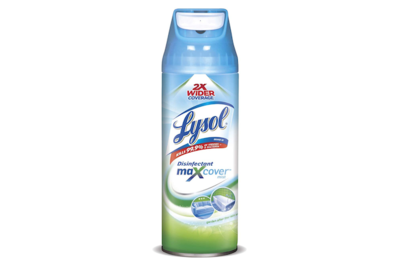
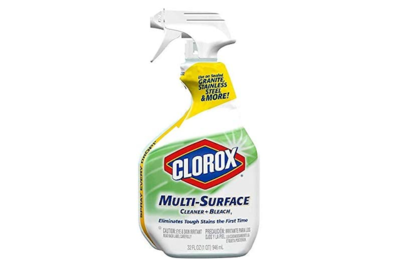
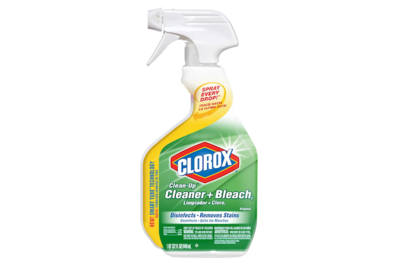

The Lysol aerosols use quaternary ammonium (quats) to kill viruses and have an EPA List N dwell time—the time they need to sit on a surface to eliminate the virus—of 10 minutes. The Lysol Kitchen Pro spray is also quats-based but has a dwell time of only two minutes. The sprays are safe to use on almost any solid surface and won't damage most fabrics, but they are not guaranteed to disinfect soft surfaces. (They may "sanitize" such surfaces, which means eliminating a very high percentage of pathogens but not all.)
The three bleach-based sprays are only for use on hard surfaces, including metals (such as faucets) and ceramics (tile, quartz, porcelain), because bleach damages most fabrics. Bleach also produces noxious fumes and is tough on skin, so be careful to ventilate and to wear gloves when using any of these bleach-based sprays.
Several other widely sold sprays, aerosols, and liquids are on the EPA's List N, meaning they are approved to kill the novel coronavirus when properly employed. If you already have or can find any of them, they are reliable. Two that may be more common are Clorox Solutions Advanced Formula Disinfecting Stain & Odor Remover (hydrogen peroxide, five-minute dwell time, spray bottle or liquid) and Clorox Scentiva Bathroom Disinfecting Foam Cleaner (quats, five minutes, aerosol foam). We do not recommend toilet-bowl cleaners for disinfecting purposes because they are thickened gels designed to stick to toilet surfaces and thus are hard wipe off—a key step in proper disinfection.
The other ready-to-use aerosols, sprays, and liquids ("RTU") on List N are aimed at medical, pharmaceutical, and professional cleaning services. Some have been sold in the past through Amazon and other general retailers, but we have found none in stock at this writing. If you wish to conduct your own search, scanning List N for the term "RTU" will bring all of these items up one by one. Take note of the "Active Ingredient/s" column, as some are based on bleach (sodium hypochlorite), which can damage some surfaces. Those based on quaternary ammonium (quats) are generally fabric-safe but guaranteed to eliminate the coronavirus only on hard surfaces. The same holds for those based on hydrogen peroxide. In all cases, take such reasonable precautions as you can, such as wearing kitchen gloves and ensuring proper ventilation.
A homemade disinfectant spray

Our pick
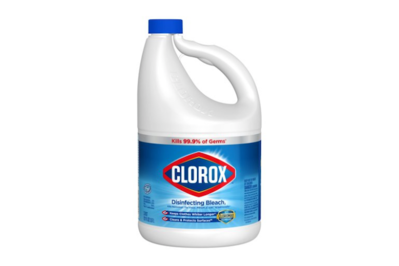
A mixture of regular household bleach and water can disinfect hard surfaces of the coronavirus. If you have bleach on hand, you can make your own mix and dispense it with a spray bottle or with paper towels.
Multiple sources give different bleach-to-water ratios for use with regular bleach. The CDC says that "[u]nexpired bleach will be effective against coronaviruses" in a 1:48 solution (⅓ cup of bleach per gallon of water, or 4 teaspoons per quart). Clorox recommends a slightly stronger 1:32 ratio (½ cup per gallon or 2 tablespoons per quart). Warner recommends a much stronger 1:10 ratio (about 1½ cups per gallon of water, or about ⅓ cup per quart). Some medical disinfectants (for example, Clorox Healthcare Bleach Germicidal Cleaner) are essentially the same solution.
Whichever ratio you use, aim for a dwell time of 10 minutes: Warner told us that this is the EPA's guideline for any new or unknown pathogen, and it is also the dwell time listed for the regular household bleaches on the EPA's List N.
Don't mix up more at one time than you will use within a day or two. Bleach degrades fairly rapidly once taken from its original storage container, becoming less effective with each passing day. Storing the container away from light can prolong its useful lifespan. If your bottle of bleach is expired, add a bit extra to the mixture, and then try to find a fresh bottle when you can.
You can use these mixtures only on hard surfaces—they will permanently damage most fabrics and many other soft materials—and they are unpleasant to work with. Wear gloves. Ventilate the space as well as possible. "Bleach is corrosive, even the vapors," said Warner. "Gives you a sore throat, you don't taste dinner, and you wake up the next day with a weird taste in your mouth."
You also need to wipe it off after the 10-minute dwell time, because left to sit indefinitely, bleach can damage even resilient materials like stainless steel. And it can cause some plastic containers to break down over time. (I used to keep some in an industrial spray bottle for bathroom use; the screw top fell apart after about a year, though the bottle itself, made of a different type of plastic, was fine.)
But in this moment, those are secondary concerns. "As you know, Tim, disinfectants are high demand and low supply," Warner told me. "People are asking me all day long, every day, 'What can we use if we don't have a hospital-grade disinfectant?' The advice I'm giving you is the advice I'm giving everyone. This is gonna be the best you can do: Apply a disinfectant [even one not on List N] and give it a 10-minute dwell time. Or mix some bleach up at 1-to-10. That gives you your best shot."
Before you begin mixing up any bleach solutions, especially if you're new to this, be sure to thoroughly read over the entire warning label on the bottle of bleach and exercise an abundance of caution in storage, handling, and cleaning up afterward. Information on avoiding "irreversible eye damage and skin burns" is worth your time.
And never, ever mix bleach with ammonia or anything containing ammonia (such as many window cleaners), or with anything acidic (such as white vinegar and many lime scale or rust removers, including CLR and Bar Keepers Friend). Doing either will produce highly dangerous and even deadly gases.
How to use disinfectant sprays and wipes
To disinfect a surface, by far the most important consideration is what's known as dwell time: the amount of time the disinfectant needs to remain on a surface to kill pathogens in general and specifically the coronavirus that causes COVID-19. No disinfectant works instantly; most of those sold to the public take several minutes. "I can tell you this, and you can print this," Warner said, "that the EPA, when they're dealing with an unknown pathogen—an unknown bacteria or virus—the protocol is 10 minutes across the board, in health care and anywhere." That said, he added, "If they get EPA registration [on List N, for the coronavirus] for a dwell time of two minutes, one minute, that's valid. It's been tested."
Different dwell times don't indicate that one disinfectant is more or less effective than another. They're just how long a given product takes to completely eliminate the coronavirus. "The EPA frowns on the use of dwell-time claims being used as an indication that one is better than the other," Warner wrote in a follow-up email. "EPA List N registration supersedes all other claims, and documents each disinfectant as effective or not (equally)."
But dwell time is not the only thing you need to pay attention to.
Complete disinfecting protocol includes, officially, four steps: pre-cleaning, disinfecting, wiping clean, and rinsing with water. "But we're lucky if we get two," Warner said, meaning dwell time and wipe-up. Cleaning is most important on heavily soiled surfaces, because dirt can shield pathogens underneath; soap and water or a household cleaner is fine for this step. Disinfecting for the proper dwell time, of course, is nonnegotiable. Wiping clean afterward is important because disinfectants can leave a sticky residue where pathogens can quickly resettle. Rinsing "you mostly see in the pharmaceutical industry," Warner said, and can probably be skipped.
Lastly, as Warner wrote in a follow-up, it's best to dispose of prepackaged wipes or paper towels that you've used to disinfect surfaces. Reusable cloths and mops "should be exchanged for a new one often during a cleaning process, then laundered." In medical facilities, he said, they are used for a maximum of three rooms before being washed. With a paper towel shortage, reusable cloths might be the way to go at home, too—let's just hope you can still find some laundry detergent.
Notable alternatives
We are recommending several new products that are EPA List N-certified against the SARS-Cov-2 coronavirus and are fairly widely available. Of possible interest to readers concerned about the most common antimicrobial compounds used in household cleaners, three are based on neither bleach nor quaternary ammonium compounds ("quats").
Cleanwell's Botanical Disinfectant Bathroom Cleaner and Botanical Disinfecting Wipes are based on thymol, a broad-spectrum antimicrobial and pesticide extracted from certain plants (including its namesake thyme). They are for use on hard nonporous surfaces and have a dwell time of 10 minutes. The EPA, in its thymol fact sheet (PDF), says, "Thymol, thyme essential oil and thyme (spice) are listed by the Food and Drug Administration (FDA) as foods for
human consumption, as well as food additives. They are considered Generally Recognized as Safe or GRAS."
Fantastik All-Purpose Cleaner is quats-based, for use on hard nonporous surfaces, and has a dwell time of three minutes. The similar Fantastik Multi-Surface Disinfectant Degreaser has a dwell time of five minutes.
The competition
Pine-Sol Original Multi-Surface Cleaner has received List N certification. However, it must be used full-strength, and must be left to sit for 10 minutes, then rinsed and wiped clean. (In normal use, it is diluted by the ratio of ¼ cup per gallon of water.) It is safe on most nonporous surfaces, but not on aluminum or copper, nor on unsealed wood.
Since we first updated this guide to address the coronavirus in March 2020, we have found and tested two new promising List N hard-surface disinfectants, Pure Hard Surface and Force of Nature.
Pure Hard Surface is a broad-spectrum disinfectant that's widely used in healthcare, laboratory, janitorial, and restaurant settings. It's a unique silver dihydrogen citrate solution that's certified as safe for use even on food-contact surfaces, and it has the EPA's lowest toxicity rating, Level IV (PDF), meaning that it's considered to have such low toxicity that no warning label is needed for oral exposure, inhalation, or skin or eye contact. It also has a very short List N dwell time of 1 minute against the coronavirus, making surface disinfection quick; and it has a five-year shelf life. At least two Wirecutter staffers (guide co-author Tim Heffernan and staff writer Thom Dunn) have used it during the pandemic, and can confirm that it's odorless, has no impact on hard kitchen and bathroom surfaces, and does not adversely affect fabrics (although it is not certified to disinfect them). Unfortunately, it is not yet widely available at retail. The chief retail distributor, Purely Better, may have it available sporadically, as may some groceries, medical suppliers, and other outlets; Tim found his gallon jug at a tattoo-supply shop. A representative told us that they are working on increasing retail supply, with a rough timeline of late 2020 or early 2021. If a regular supply becomes available, Pure Hard Surface will become a pick. Meantime, we recommend it if you find it.
Force of Nature is a disinfectant system that is List N certified for ridding hard surfaces of the coronavirus. Unique among the disinfectants we've looked at, you make the disinfectant yourself using equipment the company sells as kits. You fill a small electric-kettle-like device with tap or bottled water, add a salt-and-vinegar solution from pre-measured capsules, and turn it on. In about 10 minutes, the result is a solution of hypochlorous acid and a tiny amount of sodium hydroxide. This goes into a spray bottle (also provided) for dispensing. Hypochlorous acid is wide-spectrum disinfectant that is used in industrial settings and as a topical disinfectant on wounds, and is safe for use on most hard surfaces and bleach-safe fabrics. However, with a dwell time of ten minutes, it is slower-acting on the coronavirus than many of our picks, meaning lots of waiting around for it to do its work. And though the hypochlorous acid solution is shelf-stable for two weeks, the device only produces 12 ounces at a time. We worry that the ongoing cost of capsules would begin to add up for many households.
Below are the all-purpose cleaners we tested in an earlier version of this guide. None are considered disinfectants, so while the pandemic is ongoing, we are not recommending them as a first choice. That said, all of them contain surfactants, a class of compounds that break up fats and make them soluble in water. That's the same chemical process that makes ordinary soap and dish detergent effective against the virus when hand-washing.
Puracy Natural Multi-Surface Cleaner, our former top pick, did best overall while not damaging any surfaces. Our tests encompassed all-purpose cleaners' ability to remove multiple stains and soils on hard surfaces and pans, including cooking oil, wine, baked-on tomato sauce, soap scum, and crayon on walls (which none was effective at removing).
are nice and clean brand wipes fragrance free ?
Source: https://www.nytimes.com/wirecutter/reviews/best-all-purpose-cleaner/
Posted by: gainesspor1977.blogspot.com

0 Response to "are nice and clean brand wipes fragrance free ?"
Post a Comment